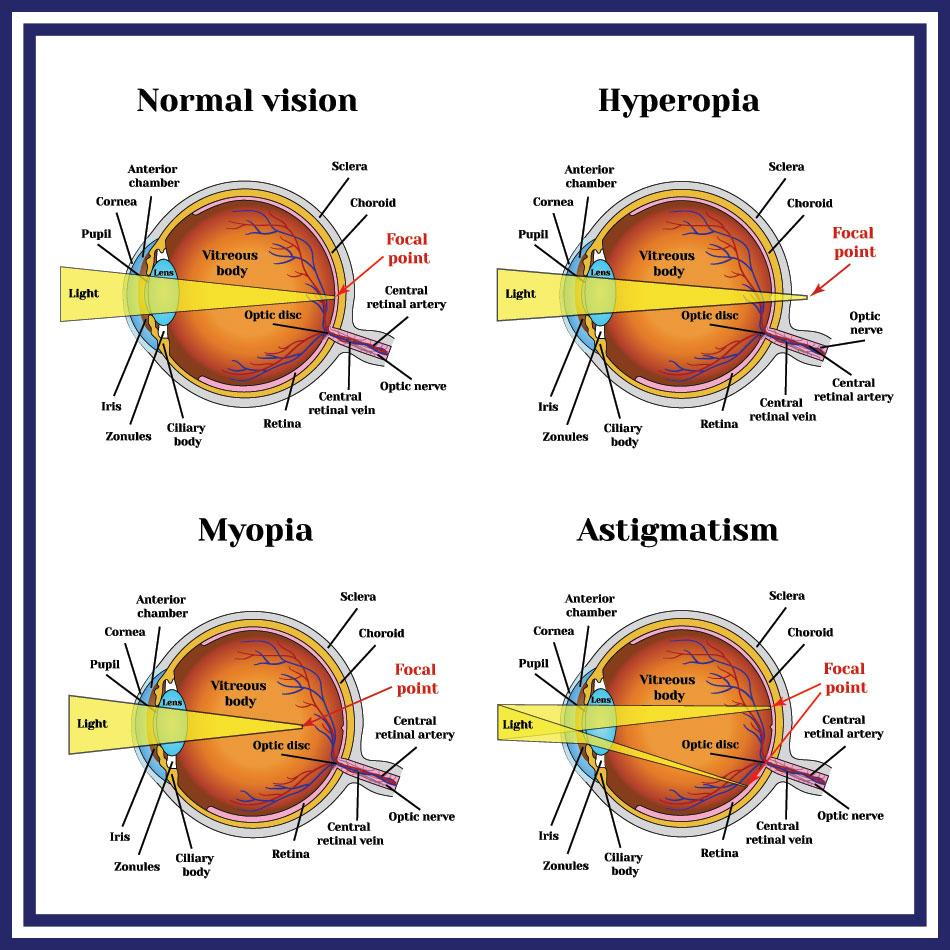
Correcting Vision Problems With Contact Lenses
If you're someone who struggles with vision problems, you're not alone. Fortunately, there are multiple solutions available to help you improve your eyesight and regain visual clarity. One popular option is using contact lenses. These small, thin lenses can be placed directly on the surface of your eyes to correct refractive errors such as nearsightedness, farsightedness, and astigmatism. In this article, we will explore the benefits of correcting vision problems with contact lenses, and how they can provide a convenient and comfortable alternative to traditional glasses. Whether you're new to contact lenses or considering making the switch, read on to discover more about this effective vision correction method.
Types of Vision Problems
Nearsightedness
Nearsightedness, also known as myopia, is a common vision problem where objects in the distance appear blurry, while close-up objects remain clear. This occurs because the eyeball is slightly longer than normal or the cornea is too curved. If you often have trouble seeing things that are far away, you may be nearsighted.
Farsightedness
Farsightedness, or hyperopia, is the opposite of nearsightedness. With farsightedness, you can see objects that are far away more clearly than those up close. This occurs if your eyeball is shorter than normal or your cornea is flatter. If you find it difficult to focus on nearby objects, you may be farsighted.
Astigmatism
Astigmatism is a common vision problem caused by an irregularly shaped cornea or lens. This causes blurred or distorted vision at all distances. People with astigmatism may experience a combination of nearsightedness and farsightedness. If you have astigmatism, objects may appear blurry or stretched out.
Presbyopia
Presbyopia is a vision condition that usually affects people over the age of 40. It is caused by the natural aging process of the lens in the eye, which becomes less flexible over time. This leads to difficulty focusing on objects up close, such as reading or using a smartphone. If you are experiencing blurred vision when looking at close objects, you may have presbyopia.
Understanding Contact Lenses
Definition and Purpose
Contact lenses are medical devices that are placed directly on the surface of the eye. They are designed to correct vision problems such as nearsightedness, farsightedness, astigmatism, and presbyopia. Contact lenses provide a clear and natural vision without the need for wearing eyeglasses. They can also be used for cosmetic purposes, changing the color or appearance of the eyes.
Advantages over Glasses
Contact lenses offer several advantages over eyeglasses. They provide a wider field of vision, as they move with your eye and don't have frames that can obstruct your peripheral vision. Contact lenses also do not fog up or get splattered with rain, making them ideal for outdoor activities. They can be more aesthetically pleasing since they don't alter your appearance like eyeglasses can. Additionally, contact lenses are suitable for people with active lifestyles, as they don't interfere with sports or physical activities.
Different Types of Contact Lenses
Contact lenses come in a variety of types to suit different vision needs. The two primary categories are soft contact lenses and rigid gas permeable (RGP) contact lenses. Soft contact lenses are made of a water-absorbing material and are known for their comfort and flexibility. RGP lenses are made of a rigid plastic material and allow for more oxygen flow to the cornea. There are also specialty contact lenses available for specific conditions or preferences, such as toric lenses for astigmatism and multifocal lenses for presbyopia.
Choosing the Right Contact Lenses
Consulting an Eye Care Professional
When it comes to choosing the right contact lenses, it is essential to consult an eye care professional. They will conduct a comprehensive eye examination to determine your vision needs and evaluate the health of your eyes. An eye care professional will consider factors such as your prescription, lifestyle, and any specific eye conditions or sensitivities you may have. Their expertise will ensure that you are fitted with the most suitable and comfortable contact lenses.
Consideration for Lifestyle and Activities
Another crucial factor in choosing the right contact lenses is considering your lifestyle and activities. If you are involved in sports or other physical activities, contact lenses that provide excellent stability and don't easily dislodge may be recommended. Similarly, if you spend most of your day working on a computer, contact lenses that provide extended comfort and minimize eye strain may be more suitable. It is essential to communicate your lifestyle needs with your eye care professional to find the best contact lenses for you.
Prescription and Fitting
To ensure optimal vision correction and comfort, it is crucial to have an accurate prescription and proper fitting of your contact lenses. Your eye care professional will measure your eye's curvature and size using specialized instruments. This information, along with your prescription, will guide them in selecting the appropriate contact lens design and parameters. Fitting includes assessing the lens's position on the eye, the movement during blinking, and the overall comfort. Regular follow-up appointments are necessary to monitor your eye health and make any necessary adjustments to your contact lens prescription or fit.
Examination and Prescription
Importance of Regular Eye Exams
Regular eye exams are essential for maintaining healthy vision and detecting any changes or issues with your eyes. During an eye exam, the eye care professional will assess your visual acuity, test for refractive errors, and check the health of your eyes. They will also evaluate any existing vision problems, such as nearsightedness, farsightedness, astigmatism, or presbyopia. Regular eye exams allow for early detection of any potential eye conditions or diseases, ensuring timely intervention and proper vision correction.
Gathering Information for Prescription
To provide an accurate prescription for contact lenses, the eye care professional will gather specific information during your eye exam. They will measure your visual acuity for both distance and near vision. Additionally, they will assess your eye movement, focusing ability, and coordination between both eyes. The eye care professional will also inquire about your lifestyle, including your occupation, daily activities, and hobbies. This information helps in determining the most appropriate contact lens prescription that meets your visual needs and takes into account any unique requirements.
Measurements and Assessments
During the examination, various measurements and assessments are performed to ensure an accurate contact lens prescription. The eye care professional will measure your corneal curvature using a device called a keratometer. This measurement helps in determining the proper fit of the contact lenses and their base curve. They may also use corneal topography, a more detailed mapping of the cornea's shape, to assess any irregularities or astigmatism. Additionally, the eye care professional will evaluate the size and health of your tear film, as it plays a crucial role in contact lens comfort and vision quality.

This image is property of www.nih.gov.
Types of Contact Lenses
Soft Contact Lenses
Soft contact lenses are the most commonly prescribed type of contact lenses. They are made of a hydrophilic material that absorbs water, providing flexibility and comfort. Soft contact lenses can correct various vision problems, including nearsightedness, farsightedness, astigmatism, and presbyopia. They come in different wearing schedules, such as daily disposable, weekly or bi-weekly replacement, or monthly replacement. Some soft contact lenses are also designed for extended wear, allowing them to be worn continuously for a specific period.
Rigid Gas Permeable Contact Lenses
Rigid gas permeable (RGP) contact lenses, also known as rigid or hard contact lenses, are made of a durable plastic material that allows oxygen to pass through. These lenses provide excellent visual acuity and are ideal for people with astigmatism or corneal irregularities. RGP lenses maintain their shape on the eye, which can help in correcting certain vision problems. They offer longer durability and are resistant to deposit buildup, making them easier to clean and maintain. However, compared to soft contact lenses, RGP lenses may require a longer adaptation period.
Specialty Contact Lenses
Specialty contact lenses are designed for specific vision needs or preferences. Toric contact lenses are specially designed for astigmatism and have different powers in different meridians of the lens. Multifocal contact lenses are used to correct presbyopia and provide clear vision at various distances. These lenses have different zones for near, intermediate, and distance vision. Color contact lenses are another type of specialty lens that can change the color or enhance the appearance of the eyes. It is important to consult with an eye care professional to determine if specialty lenses are suitable for your individual needs.
Caring for Contact Lenses
Cleaning and Disinfecting
Proper cleaning and disinfection of contact lenses are vital for maintaining good eye health and preventing infections. It is essential to follow the instructions provided by your eye care professional and the contact lens manufacturer. Generally, this involves rubbing the lenses with a recommended contact lens solution to remove debris and microorganisms. After cleaning, the lenses should be stored in a clean case with fresh disinfecting solution. It is important to avoid using tap water or saliva to clean or store contact lenses, as they can introduce harmful bacteria.
Storage and Handling
Contact lenses should be stored in a clean and dry contact lens case when not in use. The storage case should be replaced regularly to prevent the buildup of bacteria or fungi. It is important to use the recommended contact lens solution to fill the case and completely submerge the lenses. When handling the lenses, it is necessary to wash your hands thoroughly with soap and dry them with a lint-free towel. Avoid touching the lenses with sharp objects, such as fingernails, as they can cause tears or scratches.
Replacing and Renewing
Contact lenses have a specific lifespan, and it is important to follow the recommended replacement schedule provided by your eye care professional. Some contact lenses are designed for daily disposable use and should be discarded after each use. Others may be replaced weekly, bi-weekly, or monthly, depending on the lens type and wearing schedule. Using contact lenses beyond their recommended lifespan can increase the risk of eye infections and discomfort. Regular renewal of contact lenses helps maintain good vision quality and reduces the buildup of deposits on the lens surface.

This image is property of static.visiondirect.info.
Benefits and Advantages of Contact Lenses
Improved Vision Clarity
Contact lenses provide excellent vision clarity as they directly correct the refractive errors of the eye. By placing the lens right on the surface of the eye, they eliminate the image distortion that can occur with eyeglasses due to the distance between the lens and the eye. Contact lenses offer a wider field of vision, providing a more natural and immersive visual experience.
Enhanced Peripheral Vision
One of the significant advantages of contact lenses is their ability to provide enhanced peripheral vision. Unlike eyeglasses, which have frames that can obstruct your side vision, contact lenses allow for an unobstructed view of your surroundings. This is particularly beneficial for activities such as driving, sports, or any situation where being aware of your surroundings is crucial.
Better Compatibility for Physical Activities
Contact lenses are an ideal choice for people with active lifestyles or those who engage in physical activities. They do not interfere with sports equipment, helmets, or protective gear, unlike eyeglasses. Contact lenses also provide better stability during movement, as they move with your eye. They are less likely to slip or get displaced, allowing you to maintain clear and comfortable vision during physical activities.
Potential Risks and Considerations
Allergic Reactions
Some individuals may experience allergic reactions to the materials used in contact lenses or their cleaning solutions. This can lead to redness, itching, or swelling of the eyes. It is important to consult with an eye care professional if you experience any allergic symptoms while wearing contact lenses. They can recommend alternative lens materials or solutions that are less likely to cause an allergic reaction.
Dry Eyes
Contact lenses can contribute to dry eyes, particularly in individuals who already have dry eye syndrome. The lenses can reduce the amount of oxygen reaching the cornea, resulting in dryness and discomfort. It is important to use lubricating eye drops recommended by your eye care professional to keep the eyes hydrated. If dryness persists, your eye care professional may suggest different contact lens materials or wearing schedules that are more suitable for your eyes.
Infection and Irritation
Improper care and handling of contact lenses can increase the risk of eye infections and irritation. Failure to clean and disinfect the lenses properly can lead to the colonization of bacteria or fungi on the lens surface. This can cause conditions such as bacterial keratitis or fungal keratitis, which require immediate medical attention. It is crucial to follow proper hygiene practices and care instructions provided by your eye care professional to minimize the risk of infections and irritation.

This image is property of sa1s3optim.patientpop.com.
Tips for Comfortable Contact Lens Wear
Proper Hygiene and Cleanliness
Maintaining proper hygiene and cleanliness is crucial for comfortable contact lens wear. Wash your hands thoroughly with soap before handling your contact lenses. Avoid using moisturizing soaps or creams that can leave residue on the lenses. Dry your hands with a lint-free towel to prevent lint or debris from transferring onto the lenses. Regularly clean and disinfect your contact lens case, and replace it every three to six months. Avoid touching the tip of the contact lens solution bottle to prevent contamination.
Following Usage Guidelines
Follow the recommended usage guidelines provided by your eye care professional and the contact lens manufacturer. This includes wearing the lenses for the recommended duration and replacing them as instructed. Avoid wearing contact lenses while swimming or in hot tubs, as they can come into contact with contaminated water. Remove your contact lenses before going to bed, unless they are specifically designed for extended wear. Proper usage and adherence to guidelines will help maintain optimal comfort and reduce the risk of complications.
Avoiding Overwearing
Overwearing contact lenses can lead to discomfort, dryness, and an increased risk of eye infections. It is important to adhere to the recommended wearing schedule and allow your eyes to rest. If you experience any signs of discomfort, redness, or irritation, remove your contact lenses and consult with your eye care professional. They may recommend a different lens material or wearing schedule that better suits your eyes' needs.
Alternatives to Contact Lenses
Eyeglasses
Eyeglasses are a common alternative to contact lenses for vision correction. They are available in various styles, designs, and lens options to suit individual preferences. Eyeglasses offer convenience, as they are easy to clean and put on. They also provide protection for the eyes by acting as a barrier against dust, debris, and harmful UV rays. The primary drawback of eyeglasses is their limitation in peripheral vision, which can be overcome by using contact lenses.
Corrective Surgery
Corrective surgery, such as LASIK or PRK, is an option for some individuals looking for a permanent solution to their vision problems. These surgeries reshape the cornea to correct refractive errors and reduce or eliminate the need for contact lenses or eyeglasses. However, not everyone is a suitable candidate for corrective surgery, and it is important to consult with an eye care professional to determine if you are eligible.
Orthokeratology
Orthokeratology, also known as ortho-k or corneal reshaping therapy, is a non-surgical approach to vision correction. It involves wearing specially designed gas permeable contact lenses overnight to reshape the cornea temporarily. Upon waking and removing the lenses, the cornea retains its new shape, providing clear vision throughout the day. Orthokeratology is primarily used for the temporary correction of myopia and can be an alternative to wearing contact lenses or eyeglasses during the day. It requires regular follow-up visits with an eye care professional to monitor the corneal changes and ensure optimal vision correction.
In conclusion, contact lenses offer a convenient and effective way to correct various vision problems. They provide improved vision clarity, enhanced peripheral vision, and better compatibility for physical activities. However, it is essential to consult an eye care professional to determine the most appropriate contact lenses for your individual needs. Proper care and hygiene practices must be followed to ensure comfortable and safe contact lens wear. While contact lenses may not be suitable for everyone, alternatives such as eyeglasses, corrective surgery, or orthokeratology are available. Remember to prioritize your eye health and schedule regular eye exams to maintain optimal vision and address any changes or concerns.

This image is property of d31g6oeq0bzej7.cloudfront.net.


